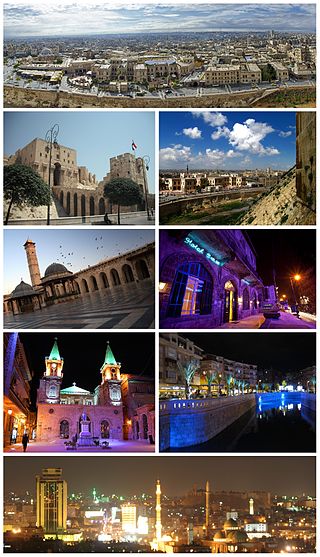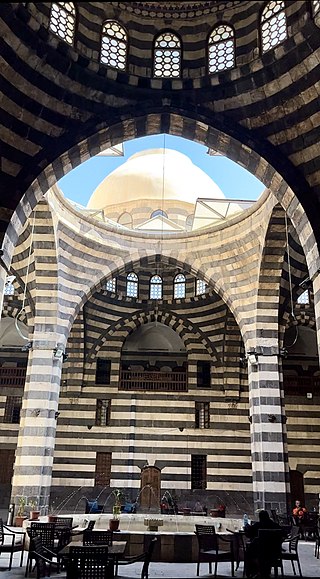
Aleppo is a city in Syria, which serves as the capital of the Aleppo Governorate, the most populous governorate of Syria. With an estimated population of 2,098,000 residents as of 2021, it was Syria's largest city until its population was surpassed by Damascus, the capital of Syria, the largest in Syria's northern governorates and also one of the largest cities in the Levant region.

Syria is a traditional society with a long cultural history. Importance is placed on family, religion, education and self-discipline and respect. The Syrian's taste for the traditional arts is expressed in dances such as the al-Samah, the Dabkeh in all their variations and the sword dance. Marriage ceremonies are occasions for the lively demonstration of folk customs.

The Citadel of Aleppo is a large medieval fortified palace in the centre of the old city of Aleppo, northern Syria. It is considered to be one of the oldest and largest castles in the world. Usage of the Citadel hill dates back at least to the middle of the 3rd millennium BCE. Occupied by many civilizations over time – including the Greeks, Armenians, Romans, Byzantines, Ayyubids, Mamluks and Ottomans – the majority of the construction as it stands today is thought to originate from the Ayyubid period. An extensive conservation work took place in the 2000s CE by the Aga Khan Trust for Culture, in collaboration with Aleppo Archeological Society. Dominating the city, the Citadel is part of the Ancient City of Aleppo, an UNESCO World Heritage Site since 1986 CE. During the 2010s, the Citadel received significant damage during the lengthy Battle of Aleppo. It was reopened to the public in early 2018 CE with repairs to damaged parts underway, though some of the damage will be purposefully preserved as part of the history of the citadel. The citadel was damaged by the 2023 Turkey–Syria earthquake.

Al-Azm Palace is a palace in Damascus, Syria, built in 1749. Located north of Al-Buzuriyah Souq in the Ancient City of Damascus, the palace was built in 1749 to be the private residence for As'ad Pasha al-Azm, the governor of Damascus; during the French Mandate for Syria and the Lebanon, it housed the French Institute.

The Citadel of Damascus is a large medieval fortified palace and citadel in Damascus, Syria. It is part of the Ancient City of Damascus, which was listed as a UNESCO World Heritage Site in 1979.

The State of Damascus was one of the six states established by the French General Henri Gouraud in the French Mandate of Syria which followed the San Remo conference of 1920 and the defeat of King Faisal's short-lived monarchy in Syria.

The 2008 Arab Capital of Culture was chosen to be Damascus, Syria. The Arab Capital of Culture is an initiative undertaken by UNESCO, under the Cultural Capitals Program, to promote and celebrate Arab culture and encourage cooperation in the Arab region. The preparation for the festivity began in February 2007 with the establishing of the Administrative Committee for “Damascus Arab Capital of Culture" by a presidential decree.

Khan As'ad Pasha is the largest caravanserai in the Old City of Damascus, covering an area of 2,500 square metres (27,000 sq ft). Situated along Al-Buzuriyah Souq, it was built and named after As'ad Pasha al-Azm, the governor of Damascus, in 1751–52. Khan As'ad Pasha has been described as one of the finest khans of Damascus, and the most "ambitious" work of architecture in the city.

The old city of Damascus is the historic city centre of Damascus, Syria. The old city, which is one of the oldest continuously inhabited cities in the world, contains numerous archaeological sites, including some historical churches and mosques. Many cultures have left their mark, especially Hellenistic, Roman, Byzantine and Islamic. In 1979, the historical center of the city, surrounded by walls of Roman era, was declared a World Heritage Site by UNESCO. In June 2013, UNESCO included all Syrian sites on the list of World Heritage in Danger to warn of the risks to which they are exposed because of the Syrian Civil War.
As'ad Pasha al-Azm was the governor of Damascus under Ottoman rule from 1743 to his deposition in 1757. He was responsible for the construction of several architectural works in the city and other places in Syria.

The Azm Palace is an 18th-century Ottoman-era palace in Hama, Syria at the center of the city on the banks of the Orontes River, about 400 meters (1,300 ft) south of the Hama Citadel. Ross Burns, author of Monuments of Syria (1999), reportedly considers the Azm Palace to be "one of the loveliest Ottoman residential buildings in Syria." The palace has been used as a regional archaeology museum since 1956.

Al-Azm family is a prominent Damascene family. Their political influence in Ottoman Syria began in the 18th century when members of the family administered Maarrat al-Nu'man and Hama. A scion of the family, Ismail Pasha al-Azm, was appointed wāli of Damascus Eyalet in 1725. Between 1725 and 1783, members of the family, including As'ad Pasha al-Azm, held power in Damascus for 47 years, in addition to periodical appointments in Sidon Eyalet, Tripoli Eyalet, Hama, Aleppo Eyalet, and Egypt Eyalet. The family's influence declined in the 19th century, failing to establish a true dynasty.

The Ancient City of Aleppo is the historic city centre of Aleppo, Syria. Prior to the Syrian Civil War, many districts of the ancient city remained essentially unchanged since they were initially constructed between the 11th and 16th centuries. Being subjected to constant invasions and political instability, the inhabitants of the city were forced to build economically independent cell-like quarters and districts, most of which were delineated along ethnic and religious lines. These urban subdistricts, along with the ancient walled city that they surround, comprise an approximate area of 350 hectares and are home to more than 120,000 residents.
The following is a timeline of the history of the city of Aleppo, Syria.
Abdullah Pasha al-Azm was an Ottoman statesman who served as the governor of the Damascus Eyalet, Aleppo Eyalet (1794), Egypt Eyalet (1798), Adana Eyalet, and Rakka Eyalet (1809), before retiring to Hama in the 1810s. He was a member of the prominent political family, Al-Azm.

Beit Ghazaleh is one of the largest and better-preserved palaces from the Ottoman period in Aleppo. It was named after the Ghazaleh family that owned it for about two centuries. Since 1914, it was used as a public school and restored to host the Memory Museum of the city of Aleppo. Beit Ghazaleh is located in the Al-Jdayde district of Aleppo. The structure has been damaged by warfare and earthquakes.
Muhammad Pasha al-Azm was the Ottoman governor of Sidon Eyalet (1763–1770) and Damascus Eyalet. He was a member of the prominent al-Azm family, the son of a former governor As'ad Pasha al-Azm.
Ismail Pasha al-Azm was an Ottoman statesman who served as the governor of Damascus and amir al-hajj in 1725–1730. Prior to this post he served as the agha of Ma'arrat al-Nu'man and steadily moved up the ranks to become the governor of the districts of Ma'arrat al-Nu'man, Hama and Homs in 1719 and then governor of Tripoli in 1721 before being assigned to the Damascus governorship.

Beit Achiqbash ; is an old Aleppine courtyard mansion built in the mid 18th Century by Qarah Ali (Karaly), a wealthy Christian merchant.












